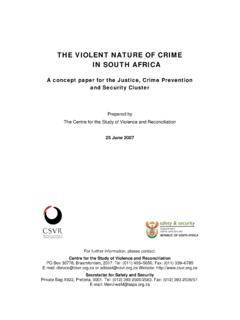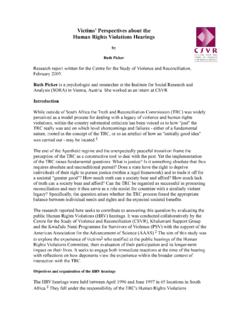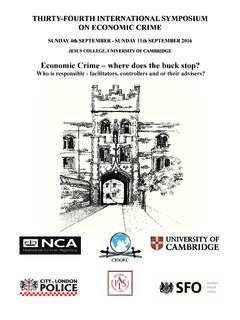Transcription of Sector Policing: What are the challenges?
1 Sector policing : what are the challenges ? by Millicent Maroga Research report written for the Centre for the Study of Violence and Reconciliation, February 2004. Millicent Maroga is a Researcher at the Centre for the Study of Violence and Reconciliation. Acknowledgements I would like to thank Gareth Newham and Themba Masuku for their assistance with this paper. Increasingly, the SAPS has started to focus on implementing a strategy called ' Sector policing '. This strategy calls for a more focused approach to policing at the local level including the establishment of ' Sector crime forums (SCFs).
2 '. Indeed, ' Sector policing ' could be seen as a form of community policing . One of the key challenges to be overcome is to ensure that these new police- community based structures do not experience the same shortcomings as community policing forums. This article will describe Sector policing as a new initiative and consider some challenges to its effective implementation and also highlight gaps within the Sector policing national draft instruction (2003). The aim is not to criticise the national daft but to highlight gaps that need consideration. what is Sector policing ? Sector policing is a UK based policing model that can be traced back to the previous decade, initially known as neighbourhood Sector policing adopts a far more decentralised approach to policing intended to address root cause of crime at specific geographical locations in partnership with particular communities at local level, Thus Sector policing can be seen as a 'tailor made' policing approach created to suit specific local needs.
3 According to Dixon,2 Sector policing in South African was mentioned as early as 1994 in the draft policy document, where then, the Minister of Safety and Security, Sidney Mufumadi talked of "community police officers with an intimate knowledge of a particular area and its problems as a main operational unit of a lean and efficient police organisation". 3 Dixon further states that despite the similarities, the term ' Sector policing ' was then not used to describe this kind of area-based problem solving In 1996 Sector policing was once again briefly mentioned in the National Crime Prevention Strategy (NCPS) as an operational strategy to addressing violence associated with inter- group conflict in Kwazulu- Natal.
4 In this case the term ' Sector policing ' was used without being defined to describe the deployment of police officers to affected The term ' Sector policing ' once again made an appearance in the 1998 White Paper on Safety and Security where it was defined as: The division of areas into smaller managerial sectors and assignment of police officers to these areas on a full time basis. These police officers regularly patrol their own sectors and are able to identify problems and seek appropriate solutions. Sector policing encourages constant contact with members of the local The white paper further states that Sector policing should be: 1.
5 Proactively, vigorously and fairly conducted 2. Based on clear instructions from the police commanders to patrol officers 3. Planned on the basis of crime analysis 4. Focused on a specific problem within an area 5. Implemented on the basis of a specific time frames 6. Developed in collaboration with the municipal police and other relevant stakeholders. The policy behind the implementation of Sector policing is to maximise effective police visibility7 and enhance accountability at the local level. Sector policing is a multi-layered policing approach. Firstly it is a crime prevention approach aimed at mobilising and engaging local communities in fighting against crime, through the establishments of Sector crime forums (SCF).
6 Sector crime forums are grounded within the same core elements that underpin community- policing forums, that is Service orientation: the provision of a professional policing service, responsive to community needs and accountably for addressing these needs Partnership: the facilitation of a co-operative, consultative process of problem solving Problem solving: the joint identification and analysis of the cause of crime and conflict and the development of innovative measures to address these Empowerment: the creation of joint responsibility and capacity for addressing crime and Accountability: the creation of a culture of accountability for addressing the needs and the concerns of communities Secondly, it is a community oriented policing approach geared towards mobilising and engaging local communities in crime prevention.
7 Thirdly, it is a step towards the development of a modern and democratic policing style addressing safety and security concerns of all South Implementation of Sector policing The implementation process of Sector policing comprises of four phases approach. The idea behind breaking down the implementation process into clearly defined phases is to enable the stations to monitor their progress and locate any challenges that may arise during the implementation process. Phase one entails dividing up of the precinct into clearly demarcated The number of sectors within a precinct will be determined by the capacity of the station, crime 'hot spots', and the size and diversity of the precinct.
8 According to the National instructions (2003), when identifying Sector boundaries the stations can either choose to align their sectors with the existing CAS blocks or municipal wards, or use infrastructure such as main roads, railway lines or taxi/bus terminals. They can also use demographic features such as the population size, cultural diversity, periodic inflow and outflow of non-residents, or demarcate according to the nature of the area residential, business or industrial. The national instruction maintains that the manner in which the sectors are identified and demarcated must be realistic and the sectors should not be too big or too many to ensure manageability.
9 Phase two entails appointing a Sector commander and a Sector team. The Sector commander will be responsible for Managing the Sector Establishing Sector crime forums Organising meetings and other events in the Sector Liasing with all the relevant community stakeholders Initiating crime prevention strategies based on the profile and the dynamic of the Sector and Reporting to the station commissioner10. The Sector team will consist of a Sector deputy, and reservists. Their role will be to assist the Sector commander in coordinating the Sector and the Sector crime forums. After the appointment of a Sector commander, follows a process of compiling a Sector profile, by the Sector commander and the Sector team.
10 A Sector profile is a detailed description of the area encompassing of the demographic make up of the area, businesses and other organisations operating within the area, prominent role players within the area, and major infrastructure within the area. In addition, it has to give an account of crime trends within the area including root causes of crime; factors giving rise to the occurrence of crime and factors inhibiting effective crime Phase four entails establishing a Sector -crime forum (SCF), envisaged to be representative of all relevant stakeholders. Two members of the community need to be appointed to serve as a secretary and a chairperson for the Sector crime forums.













